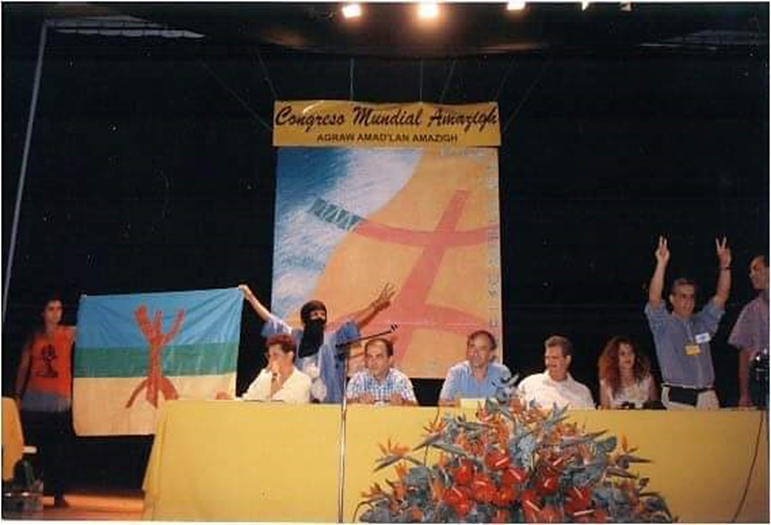The origin of the Amazigh flag (ⴰⵛⵏⵢⴰⵍ ⴰⵎⴰⵣⵉⵖ)

It was during one of my meetings in 1971 in the office of Mr. Saïd Hanouz, president of the Berber Academy, that my friend Amar Naroun, founding member, revealed to us the existence of the flag in the painting by Henri Félix Emmanuel Philippoteaux. : Presumed portraits of Chérif Boubaghla and Lalla Fadhma n'Soumer leading the revolutionary army (1866). This standard was already deployed during the uprisings led by Lalla Fadhma n'Soumer.
From 1854 to July 1857, she led a resistance against the French troops. On the painting by Henri Félix Emmanuel Philippoteaux, orientalist painter (1815-1884), dating from 1866 showing Massa Lalla Fadhma n'Soumer on his horse, a rifle in his hand, with "flag carrier" riders, we notice the flags with three colors, blue, green, yellow. This painting is visible in the living room of the presidency of the Algerian Republic (El Mouradia Palace). The Berber Academy has updated this flag by adding the Tifinagh letter aza. At that time, we did not want to reveal it so as not to give the enemies of Amazighitude a way to tax us with dividers as all these dictators of our countries of origin know how to do.

It was during the World Amazigh Congress organized in Tafira in Gran Canaria in August 1997, with other activists, that I proposed it to the first General Assembly where it was adopted as the flag of Amazighia (Tamazgha in Amazigh). The territory of the Amazighs extends from east to west from the Oasis of Siwa in Egypt to the Canary Islands, from northern Algeria to southern Niger. During my trip in 1998 to Niger in the Air, in the company of the Tuareg resistance and Commander Isyad Kato, we raised colors with this flag. It is the identity and cultural flag of Amazigh - North Africa (Tamazgha in the Amazigh language) which has 3 bands of 3 colors of the same width with the letter Yaz or aza ⴰⵣⴰ in red in the middle.
From 1854 to July 1857, she led a resistance against the French troops. On the painting by Henri Félix Emmanuel Philippoteaux, orientalist painter (1815-1884), dating from 1866 showing Massa Lalla Fadhma n'Soumer on his horse, a rifle in his hand, with "flag carrier" riders, we notice the flags with three colors, blue, green, yellow. This painting is visible in the living room of the presidency of the Algerian Republic (El Mouradia Palace). The Berber Academy has updated this flag by adding the Tifinagh letter aza. At that time, we did not want to reveal it so as not to give the enemies of Amazighitude a way to tax us with dividers as all these dictators of our countries of origin know how to do.
It was during the World Amazigh Congress organized in Tafira in Gran Canaria in August 1997, with other activists, that I proposed it to the first General Assembly where it was adopted as the flag of Amazighia (Tamazgha in Amazigh). The territory of the Amazighs extends from east to west from the Oasis of Siwa in Egypt to the Canary Islands, from northern Algeria to southern Niger. During my trip in 1998 to Niger in the Air, in the company of the Tuareg resistance and Commander Isyad Kato, we raised colors with this flag. It is the identity and cultural flag of Amazigh - North Africa (Tamazgha in the Amazigh language) which has 3 bands of 3 colors of the same width with the letter Yaz or aza ⴰⵣⴰ in red in the middle.
– the blue of the Atlantic Ocean and the Mediterranean Sea which delimits the territory to the North and West of Africa (Taferka).
– green color of lands and mountains, color of hope,
– yellow indicates the desert, space of freedom of the Tuaregs, delimits the territory in the south
– AZA in red, root of the name Amazigh symbolizing the resistance of man free standing.
Myself with the Berber Academy of the North which I founded in 1971 and whose headquarters were at 17 rue du Pays in Roubaix (1971 to 1975), I added the 7 stars above ⴰⵣⴰ in tribute to the fight of Master Antonio Cubillo founder of the MPAIAC (Movement for the Self-determination and Independence of the Canary Archipelago) whom I knew at the CRAPE, (Center for Prehistoric and Ethnological Anthropological Research) directed by Mouloud Mammeri in Algiers.
Mohand Ouramdane KHACER
– Former member of the Berber Academy.
– Founder of the Berber Academy of the North
– President of the European Berber Cultural Space Afus Deg Wfus.

https://fr.akalpress.com/5534-lorigine-du-drapeau-amazigh-%e2%b4%b0%e2%b5%9b%e2%b5%8f%e2%b5%a2%e2%b4%b0%e2%b5%8d-%e2%b4%b0%e2%b5%8e%e2%b4%b0%e2%b5%a3%e2%b5%89%e2%b5%96/

